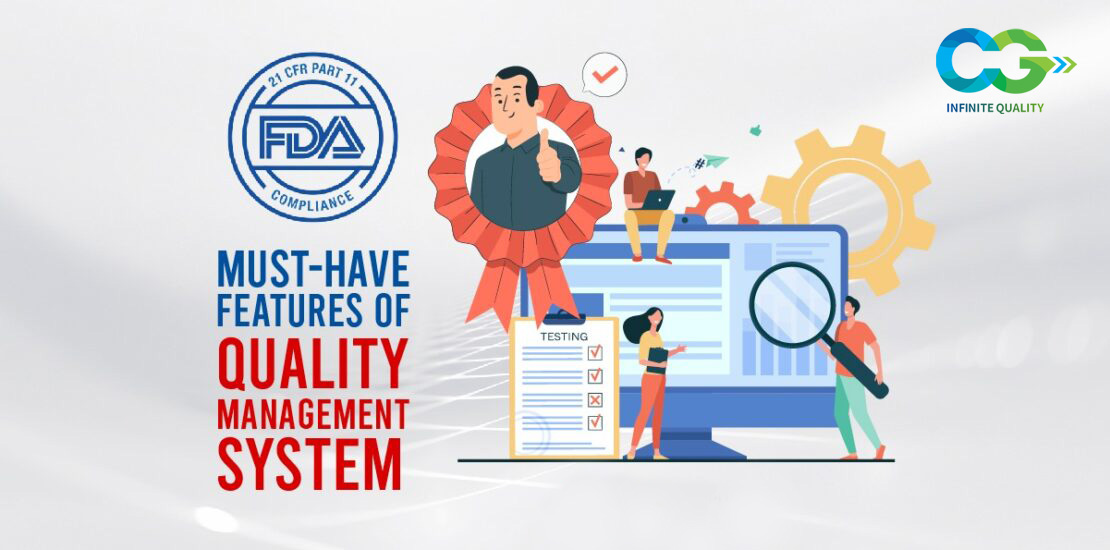21 CFR Part 11 Compliance | Must-have features of Quality Management System

Article Context:
The life sciences industry has primarily focussed on quality practices and procedures to focus on the customer needs and upon their internal efficiency to compete effectively in the market with goods that are quality, secure and safe to use.
There are two significant ISO 13485:2016 standards and FDA 21 CFR Part 11 compliance regulations. According to these, there are some must-have features in a Quality Management System (QMS) for life science organizations to align with the compliance and regulations.
As a medical device company or any life science organization considering implementing or upgrading to an electronic quality management system (eqms), it is vital to know the checklist of QMS features of the 21 CFR Part 11 compliant system. We, iQuality, have helped several life sciences organizations to find the right eQMS as an intelligent industry-leading QMS provider. Here are some must-have features to consider before searching for the best growth-oriented QMS solution. Although the below-listed features are not a specific list of components of the 21 CFR Part 11 compliance requirements checklist, the organization will meet the regulatory expectations if the implementing system addresses the listed aspects.
21 CFR Part 11 Compliant Quality Management System
Electronic Records
The foremost requirement of 21 CFR Part 11 compliance is digitalized electronic records. Because the digitally managed documents allow user-level permissions to generate automated non-editable audit trails of who, why, when, and at what levels the records have undergone, ensuring accuracy, completeness, integrity, and security of data captured and processed.
Electronic Signatures
A robust digitalized quality management system should allow the users to approve and reject the records investigation and other documents electronically through electronic signatures. Therefore, every user at the level of an approver, reviewer, or authorizer must be assigned a digital signature with a user name and password authenticating their signatures. In addition, to meet the 21 CFR Part 11 compliant system requirements, to ascertain the electronic signatures, the quality management system must contain the following
- The signer’s name.
- The document was signed on the date and time specified.
- And the significance of the signature like approval, review, author, etc.
Furthermore, the digital medium should allow the companies to add additional fields following the process.
Connectivity between records/documents and signatures
When a record is assigned for approval, the system needs to validate that the record is not in edit mode. The fields and the information filled should get frozen and is not open for editions until the record is approved or rejected by the concerned approver. In addition, all the signed records must be traceable for external and internal audit inspections.
Integrated Document Control
Several documents are included throughout the lifecycle of quality-related issues, like the procedures, processes, protocols, instructions, and product claims for managing different operations and streamlining an organization’s procedural aspects in alignment with compliance regulations. So, the 21 CFR part 11 compliant system should have automated document control capabilities. It should collect data, assign it for review and approval processes, and securely put them in a repository.
Integrated Training Management System
As per ISO and FDA’s 21 CFR standards and regulations, only skilled employees should be employed to perform the life science industry’s work specifications. The 21 CFR regulations require that the training materials be evaluated and authorized periodically. Additionally, their training records and reports must be current to prove that employees have increased their skills. Therefore, the digital quality management system should automate the training process by assigning tasks to the users, monitoring their progress, and tracking their completion and grades.
Effective Change Control Management
According to 21 CFR Part 11, the quality system should maintain time-sequenced modifications and editions of documents and other quality processes in non-editable audit trails and incorporate version and change control elements. In addition, compliance regulations require a thorough examination of the process, procedures, and practices followed to see how a company’s quality process aligns with the standards. Whenever a quality process initiates a change request, it must be captured and processed through the approvals explaining the requirement and necessity. QMS should capture the complete life cycle of change management and be processed as per the regulatory process.
System Validation
According to FDA standards, any electronic system used to manage and streamline compliance-related processes, issues, and documents must be validated. Though that is a time-consuming and costly process, the digital quality management system providers should be able to do this for the companies associated with them for implementing the QMS.
Final Thoughts
The electronic quality management system is a regulatory requirement of 21 CFR Part 11 compliance for life sciences industries. The QMS will cover all aspects of the lifecycle of the quality processes. It is a regulated compliance system of strategies and procedures for quality issues like CAPA, Non-Conformance, manufacturing, development documentation, complaints, audits, etc.
eQMS Software handles all quality processes related to documentation and tasks, allowing the companies to improve the efficiency of quality processes. So, if you are looking for an end-to-end QMS software solution integrated with document management, change control, and training management systems to more effectively manage quality-related processes, we are just a step away from a quick demonstration. Contact us at sales@complinaceg.com for scheduling a demo presentation to see an intelligent quality management system in action and compliance.
